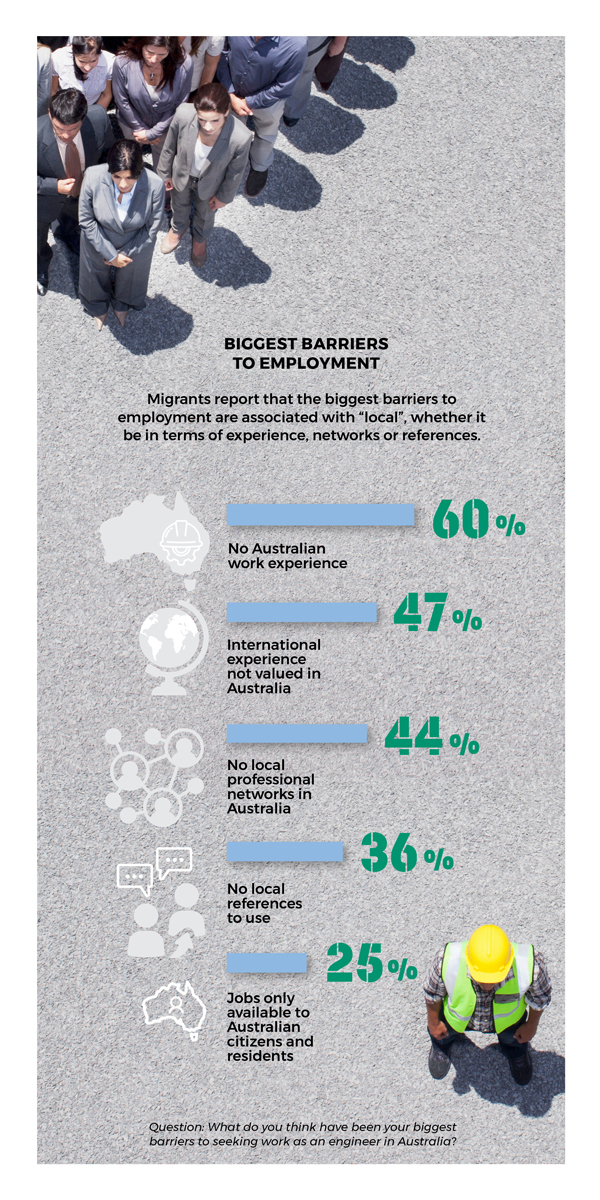Despite closed borders, a talent squeeze and record infrastructure spending, migrant engineers remain over-represented among the underemployed. A major Engineers Australia study seeks to understand barriers and help employers, migrants and the national interest.
As a young graduate, engineer Sam Matti had a seemingly promising role at a Baghdad power station – until a personally targeted death threat from the Islamic State terror group (ISIS) tucked under the windscreen wiper of his car forced him to flee.

Today, Matti is a Senior Project Manager at GHD and Site Access Lead on Melbourne’s North East Link Project.
However, like many migrant engineers, he has had to overcome significant barriers along the way to employment in his chosen profession.
In October 2012, Matti was a site engineer at Baghdad’s Al-Dora Power Plant. The role drew on his freshly minted degree from Russia’s Don State Technical University, his cross-cultural skills and his fluency in five languages. He was the perfect middleman between Russian power plant managers and his fellow Iraqi engineers.
But the job only lasted 13 months.
“I received a personally targeted death threat. My car was vandalised. An envelope on the windscreen contained a letter that said I could pay US$40,000 and leave my job, and live, or I would be killed,” Matti recalled.
“I’m an Assyrian Christian and I worked with people ISIS referred to as ‘infidel Russians’, so it was a double strike.”
With his parents, he fled to Turkey the next morning, taking only a few possessions and leaving behind his job, his home, his friends and his country, most likely forever.
He spent four long years working outside the profession — in construction in Turkey and, in Australia, as a catering assistant, an interpreter and community volunteer.
Matti had lost all faith he would ever find appropriate professional work again before landing a 12-week internship with GHD in 2017 via a CareerSeekers program that supports refugees and asylum seekers.
The internship led to a contract role and then ongoing work, all with GHD, where he still works today.
“Being displaced is a terrible thing,” Matti said. “If we give people opportunities to prove themselves then they absolutely will. That’s very good for them, and very good for the business that had faith in them.”
Vital and underused
With an emerging engineering skills shortage exacerbated by COVID-19, an engineering job vacancy rate that has gone up 97 per cent in just 12 months, and an economic recovery hinging on major infrastructure projects, the effective use of all available engineers could be considered a national strategic imperative.
“Most of the engineers working in the profession in Australia today were born overseas — 51.1 per cent. And 58.5 per cent of qualified engineers in Australia are migrants, going on Census data,” said Justine Romanis, Engineers Australia’s National Manager, Professional Diversity and STEM.
“Overseas-born engineers have a higher unemployment and significantly higher underemployment rate compared to locally born engineers. And overseas-born female engineers have almost three times the unemployment rate of Australian-born female engineers.”
Engineers Australia has publicly called for an overhaul of the skilled migration system, and given voice to these issues in a March 2021 submission to the Federal Joint Standing Committee on Migration inquiry, as well as in its evidence to the committee.
The peak body’s submission referred to an “inefficient utilisation of migrant engineers”, which sees qualified professionals more likely to work in “non-engineering roles”.
In other words, there are smart, skilled engineering professionals driving taxis and delivering takeaway while they struggle to crack the Australian jobs market — at a time when employers are reporting skills shortages.
Researching the barriers
To better understand the barriers to employment of migrant engineers, and to help develop vital solutions and help employers access this talent pool, Engineers Australia recently commissioned research.
The first phase of the project involved surveying more than 800 migrant engineers and conducting in-depth interviews with employers and recruiters, as well as migrants. It found that the biggest barriers to employment for migrant engineers are associated with “local”. Whether it’s experience, networks, standards, references or qualifications, the top five obstacles identified by migrant engineers are all to do with not being a local.

According to the research, Matti’s experience of taking a long time to find engineering work, and of falling away from the profession as a result, is common. In addition, one in three respondents (34%) with engineering jobs feel, based on their experience, that they should be in a more senior role.
Respondents report their international experience is simply not valued in Australia. This speaks to subconscious and conscious biases amongst hiring managers.
One recruiter told the research team: “I’ll get clients that tell me, ‘no Indians’. They put it on the recruiter as they can’t write it themselves.” Another advises migrant engineers to anglicise their name on their CV to get interviews.
Employers saw migrant engineers without local experience as more of a risk. Hiring managers could not “ask around” to get someone to vouch for the applicants. Many expected migrants to go initially into more junior roles, which have greater supervision, to gain local experience before being promoted.
Other employer concerns included the amount of time it would take to bring an applicant up to speed, English skills, visa complexities and cost, quality of certifications, and the risk the person might need to return overseas for family reasons.
At senior levels, an applicant’s inability to bring a network of suppliers to roles was raised with researchers.
“All employers want someone who’s worked for the competition and, unfortunately, that’s not these guys,” is the way one employer summed it up.
Migrant engineers, on the other hand, view their unique knowledge as an asset that allows them to provide a valuable skillset and fresh perspective on a project or within a business — including experience where overseas practice is ahead of Australia or projects are larger in scale.
Overcoming the employment challenge
Engineers Australia recognises the importance of improving pathways into the profession for migrant engineers.
“We absolutely value the importance of getting this right from a personal, professional and national perspective,” said Engineers Australia CEO Dr Bronwyn Evans AM HonFIEAust CPEng. “Productive employment of migrant engineers is vital to our national engineering capability.
“There is a serious mismatch between the objectives of the skilled migration program and what is being achieved in the community. Unless research is done and changes are made, we will continue to fail both migrants and employers, and put Australia’s engineering capability and future economic growth at risk.”
Engineers Australia has long been active in this arena, and its events, groups, webinars and other training opportunities offer opportunities to build local knowledge and networks, as well as contributing towards local credentials such as listing on the National Engineering Register and becoming Chartered.
One valuable resource is the Starting in the Australian Engineering Workplace online course, provided by Engineers Australia subsidiary Engineering Education Australia (EEA).
“We did some initial work with employers to identify where the issues are in terms of migrant engineers, and how we can help,” said Alexandra Sparvell, EEA’s General Manager. “The course is based on a virtual internship for international engineers we have been running for the past year as part of our Professional Year program. Over 180 engineers have been through it.
“The online course covers the Australian workplace in terms of ethical, legal, regulatory guidance; how to document your engineering workflow; what’s expected in the Australian workplace; how people work; and much more. It is very valuable for migrant engineers.”
Engineers Australia also runs local networking events and LinkedIn groups to help connect migrant engineers with employers, as well as webinars and information sessions to guide new migrants to useful resources.
In some regions, Engineers Australia has worked with organisations to promote and create employment opportunities.
For example, in Newcastle, NSW, it has worked with a local group called Northern Settlement Services on its multicultural employment program. One of its Division Committee members ran a workshop with its clients to help them with resumes, cover letters, LinkedIn profiles and more.
In Western Australia, Engineers Australia supports the Kaleidoscope Initiative — which helps migrants find secure employment in their field of expertise — by finding mentors for migrant engineers.
But there is a recognition that many of these offerings are localised and require an individual to be part of a network before they hear about them. Solutions must be broader, more inclusive and supported by all stakeholders, including employers.
An international pathway
Obafemi Adio, Acciona’s Quality and Completions Manager, has been directly involved in Engineers Australia presentations to help overseas-qualified engineers.
Having experienced the process of migration firsthand, after moving to Australia from Nigeria on a skilled migration visa, he is well placed to do so.
“I had to apply through Engineers Australia, and do an assessment,” said Adio, who had six years of engineering experience at the time he applied for a visa.
“It involved submitting all of my degree qualifications and writing about my experience, what I’d done, and what my roles were.”
That was 14 years ago. When he arrived, Adio still faced the challenge of finding work.
While Engineers Australia is empowered by the Federal Government to assess the skills of engineering professionals for skilled migration visas, it has no control over engineer migration numbers, visa eligibility criteria, visa restrictions or employer demand.
Jobs are far from guaranteed.
For Adio it meant more than simple financial security.
“I was also engaged to be married,” he said. “To bring my fiancée over, I had to prove I could look after her. This meant a job and a place for us to live. So not only was I looking for a job, but I was trying to get my family started, as well.”
Adio had a support network, of sorts. His sister lived in Australia with her husband.
“When I considered taking work outside of my training, they encouraged me against a rash decision,” he said.
“They were both professionals and they knew the value of sticking with your training.”
For Adio, the wait was a relatively short one.
“An agency found work for me on Melbourne’s EastLink project a month after I arrived,” he said.
It is a story with a happy ending: Adio is now happily married, employed, and an Australian citizen. But for many migrant engineers, the result is not so positive.
Everyone involved in the engineering sector has a role to play in ensuring the skills of migrant engineers are more fully harnessed. This includes Engineers Australia, universities, employers and recruiters.
It’s essential for the nation’s engineering capability.
“My question is this,” Evans said.
“How can Engineers Australia work with industry to help address the skills shortage by enabling them to draw on this existing talent pool? With this research project, we’re a lot closer to developing a clear answer. We want to work with employers to co-design solutions, because they will only be successful if employers embrace them. That’s the next step.”
One engineer’s career challenge
Ishmeet Kaur, a Western Australia-based telecommunications engineer for Western Power, arrived from India in 2015. This is her story.
What brought you to Australia?
I did my bachelor’s degree in India, then came to Australia to study my master’s.
What challenges did you face?
I began looking for work six months before graduating and discovered universities in Australia lag other countries on this. In India, companies come to the colleges. But here, you need to apply for jobs. A graduate program will have a deadline eight months before the recruitment process, and often migrant students simply aren’t told.
Could universities do better?
It felt as if universities in Australia don’t take the initiative to help students find work. That should be a university’s responsibility. They should conduct mandatory workshops, equip students with tools they need and make all opportunities clear. The college has a responsibility to invite companies into their recruitment process.
Where did you go for information?
All of my friends were from India — I didn’t have an Aussie network. None of us had any information we needed. I started applying for jobs and going to careers events. I researched graduate programs, but they were for the next year. I frantically looked for work for over a year while I worked at Nando’s.
How did you eventually find a job?
I went for an interview with APD Engineering in Perth and, at the time, I was even willing to work for free to gain work experience. But they instead offered me a one-year contract. I stayed with them for three years.
What can the profession do?
When people see fellow migrants working in odd jobs, it is very demotivating. Migrant engineers, and in fact all engineers, already established in their careers should take responsibility for mentoring, to make themselves more visible, to motivate younger engineers and to give back to the community.
